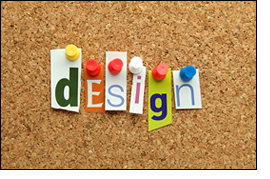Are you tired of looking at unprofessional designs for businesses and organizations? It doesn’t matter what the industry is, ugly is everywhere!
A good-looking design will not only make your business look less amateurish, but it will help with brand recognition. I’ve talked with my creative director and came up with a few quick tips to help you avoid embarrassing designs.
Please! Keep it simple…
A few years ago, Rolling Stone magazine listed eight companies with the best logos of the past 35 years—among them were FedEx, Nike, Playboy and McDonald’s. What set these logos apart from all the rest? Simplicity.
A pair of golden arches, the swoosh—these instantly recognizable logos are brilliant in their simplicity. Keeping your company’s graphics simple will make it easier for people to remember.
It’s all too easy to clutter a logo or a graphic with too much text or photos. The same idea applies to websites and publications. We are easily distracted, and a cluttered page can easily confuse.
Use the right tools for the right job.
I can tell you made that in Microsoft Word!
Readers and customers can tell the difference between professionally designed website, graphic or publication and one that was made using the wrong tools. Don’t think you can get by designing everything in Word!
Don’t get me wrong. Word is a powerful tool for writing documents, but it’s quite limited in its ability to make a professional-looking design.
Professional design software like Adobe Creative Suite will give you the power to create high-quality designs without that template look. Most newspapers and many magazines and websites are designed with Adobe software.
If you haaaavvvveee to use Microsoft Office for layouts and items of that nature, look into Microsoft Publisher. It has way more flexibility than Word.
Like many things, unity is key.
This may seem obvious, but everything should look good together. Think about your overall design—how do the individual elements complement each other and add up to a sum total?
Graphic and publication designers use the word balance a lot when describing their work, and with good reason. Don’t let your design fall heavily to one side—everything on the left should be balanced by whatever is on the right.
Lopsided designs confuse our eyes and throw off the flow of your project. Furthermore, no two elements should be in competition for attention; everything should flow naturally.
Understand color theory.
Graphic design is an art, and one of the first things artists learn is color theory. Colors create moods in design—a muted blue color brings to mind a very different emotion than a bright cherry red.
Make sure you know how the color wheel works, and what colors complement each other and which ones clash. Will an amber highlight look good with a sage background? You need to know! Using poorly chosen color combinations can turn a nicely laid-out page into a horrible eyesore.
Fonts are pretty dang important!
Even with the thousands of fonts floating around these days, font selection is an often overlooked, and poorly executed, design element. Choosing the proper font often depends on the medium. Is the output going to be print or digital?
There are both pros and cons for using serif and sans serif fonts. Many of the times, it has to do with preference. One important thing to remember is, just because a font looks “cool” doesn’t mean it’s actually legible. With that said, don’t use cursive-looking fonts for headlines or body copy; and for heaven’s sake, don’t use Comic Sans!





